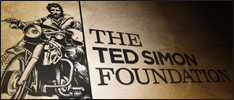Over the border and our journey continues on into Guatemala. We had a very pleasurable ride swooping along with the Rio Camatan and picking up the main road to the capital, Guatemala City where we promptly got lost on the ‘Peripherique’ missing our turn off for Antigua and riding around for ages trying to do a U Turn on the major ring road. The right road turned into a corker of a dual carriageway climbing and winding up over mountains in the late evening to suddenly spill us out onto the cobble-paved streets of Antigua Guatemala. Antigua Guatemala was the former capital of all of Spanish Central America until it was ravaged by a series of earthquakes and virtually destroyed by a major quake in 1773. Our arrival on a Sunday evening lead us into a horrible over-crowded tourist filled town and first impressions were not that great, especially when we couldn’t find a place to stay. We checked out a number of budget joints but there was either nowhere to park the bikes or they were really grubby and shabby. As it was getting dark we finally found a slightly over-priced Posada with remote secure parking, good enough for one night. Fortunately the poor initial impression didn’t last long! We started out by finding a better hotel at a cheaper rate with breakfast included. The weekend crowds had disappeared leaving us with this treasure of a city to ourselves. Similar in layout and style to Granada in Nicaragua, a grid of low pastel coloured houses and buildings, the city is totally overshadowed by the impressive 3,760 metre Volcan Agua. We are back in the land of the classic pointy cone volcano and Agua is a stunner, especially as a backdrop for a city. Lateral streets of pastel coloured houses shoot lines of perspective that all disappear to a vanishing point somewhere in the volcano – another artists paradise with every street scene just begging to be put down on canvas. Antigua also possesses an incredible quantity of old colonial churches, most of which were left in ruins after the big quake. The local authorities have worked hard to preserve the colonial architecture; a few years ago a law was passed requiring all shop signs protruding from the walls to be removed thus restoring the buildings to their original form. Most are single storied with small windows making for an interesting amble round the shops, where in most cases you have to stick your head in the door the see what’s for sale. It was a great place to spend a few days reading and planning a rough itinerary for Guatemala and also a good base to strike out for a close up look at the nearby Pacaya volcano, a very active mountain indeed.
We walked to the top of Pacaya as part of a small excursion party with a guide. It was a fairly easy ramble for an hour and a half with the last bit a “one step forwards… two steps back” shuffle on soft volcanic ash. The summit provided panoramic vistas sweeping over a trio of nearby volcanoes with the Pacific Ocean way off in the far distance. The reeky, smelly crater was at first full of cloud soup obscuring our chances of seeing any activity. However a little whispy breeze soon provided tantalising peeks of the volcano’s innards and it later cleared sufficiently to reveal a monstrous cone in the centre of the crater, spewing lava dribbles from it’s top – real fire & brimstone stuff in the witches cauldron. At long last after disappointing weather at the two other active volcanoes we visited in Ecuador and Costa Rica, we were here at last looking down the gullet of one of these awesome beasts. A red-letter day indeed!
A few days later we left Antigua and rode a short way up into more mountains to the town of Panajachel on Lago Atitlan, self-titled “most beautiful lake in the world”. It was an easy ride under blue skies and the first views of the lake where jaw-droppingly impressive. We found a small apartment for a few days whilst we scouted the area and enrolled for some Spanish classes, our main reason for coming here.








